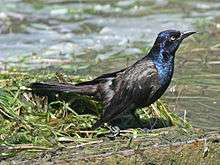Common grackle
| Common grackle | |
|---|---|
 | |
| Scientific classification | |
| Kingdom: | Animalia |
| Phylum: | Chordata |
| Class: | Aves |
| Order: | Passeriformes |
| Family: | Icteridae |
| Genus: | Quiscalus |
| Species: | Q. quiscula |
| Binomial name | |
| Quiscalus quiscula (Linnaeus, 1758) | |
| | |
| Approximate range in North America. Breeding range Year-round range Wintering range | |

The common grackle (Quiscalus quiscula) is a large icterid which is found in large numbers through much of North America.
Description

Adult common grackles measure from 28 to 34 cm (11 to 13 in) in length, span 36–46 cm (14–18 in) across the wings and weigh 74–142 g (2.6–5.0 oz).[2] Common grackles are less sexually dimorphic than larger grackle species but the differences between the sexes can still be noticeable. The male, which averages 122 g (4.3 oz), is larger than the female, at an average of 94 g (3.3 oz).[3] Adults have a long, dark bill, pale yellowish eyes and a long tail; its feathers appear black with purple, green or blue iridescence on the head, and primarily bronze sheen in the body plumage. The adult female, beyond being smaller, is usually less iridescent; her tail in particular is shorter, and unlike the males, does not keel (display a longitudinal ridge) in flight and is brown with no purple or blue gloss. The juvenile is brown with dark brown eyes.
Distribution and habitat

The breeding habitat is open and semi-open areas across North America east of the Rocky Mountains. The nest is a well-concealed cup in dense trees (particularly pine) or shrubs, usually near water; sometimes, the common grackle will nest in cavities or in man-made structures. It often nests in colonies, some being quite large. Bird houses are also a suitable nesting site. There are four to seven eggs.
This bird is a permanent resident in much of its range. Northern birds migrate in flocks to the southeastern United States.
Ecology and behavior
The common grackle forages on the ground, in shallow water or in shrubs; it will steal food from other birds. It is omnivorous, eating insects, minnows, frogs, eggs, berries, seeds, grain and even small birds and mice. Grackles at outdoor eating areas often wait eagerly until someone drops some food. They will rush forward and try to grab it, often snatching food out of the beak of another bird. Grackles prefer to eat from the ground at bird feeders, making scattered seed an excellent choice of food for them. In shopping centers, grackles can be regularly seen foraging for bugs, especially after a lawn trimming.
Along with some other species of grackles, the common grackle is known to practice "anting", rubbing insects on its feathers possibly to apply liquids such as formic acid secreted by the insects.
This bird's song is particularly harsh, especially when these birds, in a flock, are calling. Songs vary from, year round chewink chewink to a more complex breeding season ooo whew,whew,whew,whew,whew call that gets faster and faster and ends with a loud crewhewwhew! It also occasionally sounds like a power line buzzing. The grackle can also mimic the sounds of other birds or even humans, though not as precisely as the mockingbird, which is known to share its habitat in the Southeastern United States.
In the breeding season, males tip their heads back and fluff up feathers to display and keep other males away. This same behavior is used as a defensive posture to attempt to intimidate predators. Male common grackles are less aggressive toward one another, and more cooperative and social, than the larger boat-tailed grackle species.
Grackles tend to congregate in large groups, popularly referred to as a plague or annoyance. This enables them to detect birds invading their territory, and predators, which are mobbed en masse to deter the intruders.
Relationship with humans
The range of this bird expanded west as forests were cleared. In some areas, it is now considered a pest by farmers because of their large numbers and fondness for grain. Despite a currently robust population, a recent study by the National Audubon Society of data from the Christmas Bird Count indicated that populations had declined by 61% to a population of 73 million from historic highs of over 190 million birds.
Unlike many birds, the grackle benefits from the expansion of human populations due to its resourceful and opportunistic nature. Common grackles are considered a serious threat to crops by some, and notoriously difficult to exterminate and usually require the use of hawks or similar large birds of prey.[4]
Photo gallery
 Iridescent back
Iridescent back Iridescence in direct sunlight
Iridescence in direct sunlight
 Chick
Chick An albino grackle photographed in Peterborough Ontario 2012
An albino grackle photographed in Peterborough Ontario 2012 Male feeding in grass
Male feeding in grass.jpg) In Ontario, Canada
In Ontario, Canada
References
- ↑ BirdLife International (2012). "Quiscalus quiscula". IUCN Red List of Threatened Species. Version 2013.2. International Union for Conservation of Nature. Retrieved 26 November 2013.
- ↑ "Common Grackle". Cornell Lab of Ornithology.
- ↑ "Quiscalus quiscula, common grackle". Animal Diversity Web.
- ↑ "Murder Most Fowl". Time Magazine.
External links
| Wikimedia Commons has media related to the common grackle. |
| Wikispecies has information related to: Quiscalus quiscula |
- "Common grackle media". Internet Bird Collection.
- Common grackle - Cornell Lab of Ornithology
- Audubon's Common Birds in Decline Report
- Florida bird sounds including the common grackle - Florida Museum of Natural History
- Common grackle photo gallery at VIREO (Drexel University)
